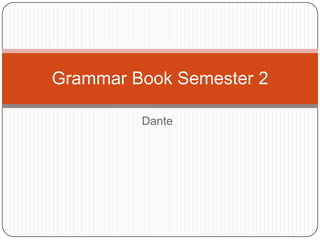
Grammar book semester 2
- 1. Dante Grammar Book Semester 2
- 2. Conditional Used to express probability, possibility, wonder, or conjecture. Can be translated as “would,” “could,” “must have been,” or “probably.” Endings attach to the end of the infinitive: -AR, -ER, A
- 3. Present Perfect The present perfect tense is used to express past actions that continue into the present or continue to express the present. The present perfect is formed by using the past participle of the verb with a conjugation of the auxiliary verb haber. Past participles are formed by adding “ado” to an –ar verb and “ido” to an –er or –ir verb.
- 4. Past Perfect The past perfect tense is used when a past action was completed prior to another past action. It is often used with the following: “ya”, “antes”, “nunca”, “todavía”, or “después”. The past perfect tense is a compound tense. To form the past perfect tense, used the imperfect form of the auxillary verb “haber” and the past participle of the verb.
- 5. Present Perfect Irregulars These verbs are irregular with respect to the formation of the past participle. To form a perfect tense, an appropriate conjugation of haber should be placed before the participle.
- 6. Subjunctive Perfect Tenese Subjunctive perfect tenses are used when a verb clause requiring the use of the subjunctive is in the present, past, or future perfect tense when expressed in the main clause. Like the indicative perfect tenses, the subjunctive verb tenses use the past participle of the verb and an appropriate conjugation of the verb haber.
- 7. Tanto y Tan “Tan” and “tanto” are both used in Spanish to express equality. Tan is used with another adjective, and tanto is used as a pronoun. Like other Spanish pronouns, the ending of tanto changes to agree with the noun it is replacing. El libroes tan buenocomo la pelicula. (The book is as good as the movie) Juan tienetantodinerocomoMaría. (Juan has as much money as Maria)
- 8. Impersonal “Se” The pronoun “se” can be used with the third person singular or plural form of a verb to express thoughts or statements that lack a definite subject. For example: Se abrenlastiendas a lasnueve de la manaña. – They open the stores in the morning. ¿Comó se dice “the dinosaur” en español? – How does one say “the dinosaur” in Spanish?
- 9. Saber vs. Conocer Both the verbs “saber” and “conocer” are translated as “to know” in English. However, they are used differently in Spanish. The verb saber is used to express knowledge of facts and information. Ex. YoséqueCristóbalCólonnacío en el 1451. The verb conocer is used to express familiarity with people, places, things, or literary works. Ex. Yoconozcosu amigo Juan.
- 10. Informal Commands To form an informal affirmative command, simply conjugate a verb to its “tú” form, and then drop the “s”. Comer – Tú come Cantar – Túcanta To form an informal negative command, first, conjugate a verb to its “yo” form. Then, add the opposite vowel ending, followed by an “s”. Comer – No tú comas Cantar – No túcantes
- 11. Formal Commands To form a formal affirmative command, conjugate a verb to its “yo” form and add the opposite vowel ending. Comer - Usted coma Cantar – Ustedcante To form a formal negative command, follow the same process used to form the affirmative formal command, but add the world “no” to the beginning of the expression. Comer – No usted coma Cantar – No ustedcante
- 12. Informal Irregular Commands These verbs take different forms in the second person affirmative imperative form. Decir – Di Hacer – Haz Ver – Vi Poner – Pon Salir – Sal Saber – Sé Tener – Ten Venir - Ven
- 13. Formal Irregular Commands These verbs (TVDISHES) take a different form in the negative second person and both the affirmative and negative third person command forms. An “s” can be added to these stems to create a negative second person command. Tener – Tenga Venir – Venga Dar - Dé Ir – Vaya Ser – Sea Hacer – Haga Estar – Esté Saber - Sepas
- 15. Subjunctive Irregulars The stems of these verbs change when conjugated in the present subjunctive. Regular subjunctive verb endings are then added, depending on the last two letters of the verb. Tener – Tenga Venir – Venga Dar - Dé Ir – Vaya Ser – Sea Hacer – Haga Estar – Esté Saber - Sepas
- 16. Impersonal Expressions Impersonal expressions, such as those shown, often denote the use of the subjunctive. Beware for expressions that appear to be impersonal expressions but convey something as a fact i.e. “esevidenteque”. These expressions should use the ordinary indicative form of a given verb.
- 17. Subjunctive Expressions of Emotion The subjunctive can also be used to express emotion. Common words used to express emotion include: The subjunctive is always used when the subject in the main clause of a complex sentence expresses emotion. When there is an expression of emotion, but no change in subject, the infinitive instead of the conjugated verb is used.
- 18. Subjunctive Conjunctions of Time The subjunctive is also used when the main clause is a command or in the potential future. For example: Trabajaréhastaquemisniños me llamen. (I will work until my children call me) These conjunctions of time are often used with the subjunctive:
- 19. Demonstratives Demonstratives – Ese - this Este - that Aquel – that Dame esolibro. Dane eso. Demonstratives can be used as nouns or pronouns. The ending of a demonstrative can change in order to agree with the noun that it describes or replaces.